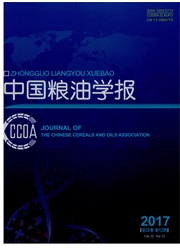

 中文摘要:
中文摘要:
通过理论分析与数值模拟相结合的方法,以典型吸湿性多孔介质一小麦为研究对象,根据小麦吸湿和解吸湿曲线,建立了吸湿性多孔介质内部热湿耦合传递的数学模型,通过与相关试验数据比较验证了数学模型的合理性。基于有限元的方法模拟分析了外界气温和小麦分别为273K(0℃)和293K(20℃),小麦初始水分为14%和18%时直径为10m高度为10m的充满小麦的圆柱仓内部热湿迁移过程,重点探究了近似冬季和夏季仓储粮堆内部温度和水分的动态变化规律。研究结果表明,冬季工况下水分从粮堆内部向顶部和右侧壁面迁移,聚集在相对狭窄的壁面边界附近,形成低温高水分区域,最大水分值出现在右上部侧壁面附近。夏季工况下水分从顶部和侧面向内迁移,而内部又朝右上部区域扩散,形成较宽的高温高水分区域(X〈4.5m,8.0m〈Y〈9.5m)。
 英文摘要:
英文摘要:
In the paper, a mathematical model for the simultaneously natural convective heat and moisture transfer had been developed by utilizing an incorporating a sorption isotherm relationship to predict moisture migration due to natural convection and diffusion within stored grain. The model was solved numerically by the Finite Element Method (FEM) to predict the natural flow patterns, temperature and grain moisture distributions on conditions ap- proximating winter and summer storage periods in a silo with 10 m in diameter a height of 16 m. The conditions ap- proximating winter and summer extremes were independently simulated for a period of 150 d in four cases with two in- itial moisture contents as 14% and 18 % (w. b. ) respectively. Two sets of constant wall and grain temperatures, 0 ℃ and 20 ℃, 20 ℃ and 0 ℃ were studied respectively. Natural convection currents had been developed in silos due to temperature gradients in approximating winter storage periods; while natural convection were counterclockwise in approximating summer storage periods. On approximate winter conditions, the moisture was concentrated in rela- tively narrow bands, near the lateral edge ; a small zone near the surface of bulk wheat, and maximum moisture con- tents occurred in upper left -hand corner in bulk wheat. On summer conditions, moisture was concentrated in the upper zones ( x 〈 4.5 m, 8.0 m 〈 y 〈 9.5 m) of the bulk wheat, which was wider and deeper than that created on the approximate winter conditions.
 同期刊论文项目
同期刊论文项目
 同项目期刊论文
同项目期刊论文
 期刊信息
期刊信息
